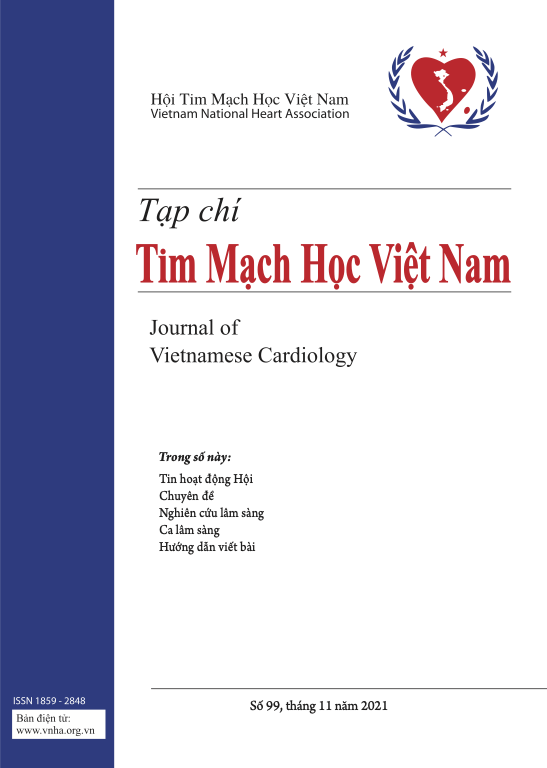Cô lập tĩnh mạch phổi bằng bóng áp lạnh (Cryoballoon): triển vọng mới trong tiếp cận điều trị rung nhĩ
Tóm tắt
TIẾP CẬN ĐIỀU TRỊ RUNG NHĨRung nhĩ là rối loạn nhịp tim phổ biến nhất hiện nay, khoảng 1-2% dân số trên thế giới được chẩn đoán mắc rung nhĩ. 1 Ước tính có khoảng 1% ngân sách y tế được sử dụng cho điều trị quản lý bệnh nhân rung nhĩ. 2 Triệu chứng rung nhĩ không chỉ ảnh hưởng chất lượng cuộc sống người bệnh mà còn gia tăng nguy cơ như tắc mạch hệ thống, đột quỵ, suy tim thậm chí tử vong. 1 Chiến lược điều trị rung nhĩ được nghiên cứu và hoàn thiện trong nhiều năm gần đây. Kiểm soát nhịp và tần số tim kết hợp với liệu pháp chống đông đường uống là điều trị nền tảng bệnh nhân rung nhĩ. Việc lựa chọn kiểm soát tần số tim hay kiểm soát nhịp tim được cân nhắc trên từng cá thể dựa trên các yếu tố chính bao gồm:
(1) Độ tuổi bệnh nhân, (2) Mức độ triệu chứng,
- Tiền sử và phân loại rung nhĩ, (4) Mối liên quan giữa rung nhĩ và sự suy giảm chức năng tim, (5) Lợi ích, nguy cơ và đáp ứng bệnh nhân với thuốc chống rối loạn nhịp tim (AAD), (6) Sự lựa chọn của bệnh nhân và (7) Quá trình tái cấu trúc tâm nhĩ.
Hiện nay đa phần thuốc kiểm soát nhịp trên bệnh nhân rung nhĩ thuộc nhóm IC và nhóm III (phân loại Vaughan Williams). Tuy nhiên, hiệu quả của thuốc trong duy trì nhịp xoang hạn chế khi theo dõi lâu dài. Từ đó, triệt đốt rung nhĩ ra đời dựa trên nguyên lý hầu hết điểm khởi phát rối loạn nhịp trong
Tài liệu tham khảo
1. Hindricks G, Potpara T, Dagres N, et al. 2020 ESC Guidelines for the diagnosis and management of atrial fibrillation developed in collaboration with the European Association for Cardio-Thoracic Surgery (EACTS). Eur Heart J. 2021;42(5):373-498. doi:10.1093/eurheartj/ehaa612.
![]()
2. Kim MH, Johnston SS, Chu BC, Dalal MR, Schulman KL. Estimation of Total Incremental Health Care Costs in Patients with Atrial Fibrillation in the United States. Circ Cardiovasc Qual Outcomes. 2011;4(3):313- 320. doi:10.1161/CIRCOUTCOMES.110.958165.
![]()
3. Marrouche NF, Brachmann J, Andresen D, et al. Catheter Ablation for Atrial Fibrillation with Heart Failure. N Engl J Med. 2018;378(5):417-427. doi:10.1056/NEJMoa1707855.
![]()
4. La Rosa G, Quintanilla JG, Salgado R, et al. Anatomical targets and expected outcomes of catheter‐based ablation of atrial fibrillation in 2020. Pacing Clin Electrophysiol. 2021;44(2):341-359. doi:10.1111/pace.14140.
![]()
5. Khairy P, Chauvet P, Lehmann J, et al. Lower Incidence of Thrombus Formation with Cryoenergy Versus Radiofrequency Catheter Ablation. Circulation. 2003;107(15):2045-2050. doi: 10.1161/01. CIR.0000058706. 82623.A1.
![]()
6. Hanninen M, Yeung-Lai-Wah N, Massel D, et al. Cryoablation Versus RF Ablation for AVNRT: A Meta- Analysis and Systematic Review: Meta-Analysis of Cryoablation for AVNRT. J Cardiovasc Electrophysiol. 2013;24(12):1354-1360. doi:10.1111/jce.12247.
![]()
7. Zhou GB, Guo XG, Liu X, et al. Pulmonary Vein Isolation Using the First-Generation Cryoballoon Technique in Chinese Patients: CRYOBALLOON ABLATION FOR ATRIAL FIBRILLATION. Pacing Clin Electrophysiol. 2015;38(9):1073-1081. doi:10.1111/pace.12675.
![]()
8. Aryana A, Kowalski M, O’Neill PG, et al. Catheter ablation using the third generation cryoballoon provides an enhanced ability to assess time to pulmonary vein isolation facilitating the ablation strategy: Short- and long- term results of a multicenter study. Heart Rhythm. 2016;13(12):2306-2313. doi: 10.1016/j.hrthm.2016.08.011.
![]()
9. Kuck KH, Fürnkranz A, Chun KRJ, et al. Cryoballoon or radiofrequency ablation for symptomatic paroxysmal atrial fibrillation: reintervention, rehospitalization, and quality-of-life outcomes in the FIRE AND ICE trial. Eur Heart J. 2016;37(38):2858-2865. doi:10.1093/eurheartj/ehw285.
![]()
10. Hermida JS, Chen J, Meyer C, et al. Cryoballoon catheter ablation versus antiarrhythmic drugs as a first-line therapy for patients with paroxysmal atrial fibrillation: Rationale and design of the international Cryo-FIRST study. Am Heart J. 2020; 222:64-72. doi: 10.1016/j.ahj.2019.12.006.
![]()
11. Andrade JG, Khairy P, Guerra PG, et al. Efficacy and safety of cryoballoon ablation for atrial fibrillation: A systematic review of published studies. Heart Rhythm. 2011;8(9):1444-1451. doi: 10.1016/j. hrthm.2011.03.050.
![]()
12. Calkins H, Reynolds MR, Spector P, et al. Treatment of Atrial Fibrillation with Antiarrhythmic Drugs or Radiofrequency Ablation: Two Systematic Literature Reviews and Meta-Analyses. Circ Arrhythm Electrophysiol. 2009;2(4):349-361. doi:10.1161/CIRCEP.108.824789.
![]()
13. Weerasooriya R, Khairy P, Litalien J, et al. Catheter Ablation for Atrial Fibrillation. J Am Coll Cardiol. 2011;57(2):160-166. doi: 10.1016/j.jacc.2010.05.061.
![]()








